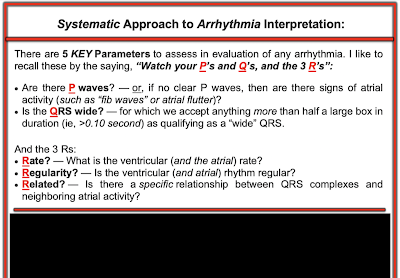======================================
CLICK HERE — for a Video presentation of this case! (19:40 min.)
- Below are slides used in my video presentation.
- For full discussion of this case — See ECG Blog #191 —
======================================
The 2-lead rhythm strip shown in Figure-1 was obtained from an elderly woman who presented to the ED following a syncopal episode. On the basis of this rhythm strip — she was diagnosed as being in complete AV Block.
- Question #1: Is there AV Dissociation in Figure-1?
- Question #2: Do YOU agree that the rhythm shown in this figure represents complete ( = 3rd-degree) AV Block?
 |
| Figure: The Ps, Qs, 3R Approach to Rhythm Interpretation. |
 |
| Figure: It does not matter in what sequence you assess the 5 Parameters (and I often change the sequence, depending on the rhythm ... ). |
=======================================================
 |
| Figure: If the AV block is neither 1st-degree nor 3rd-degree — then it will be some type of 2nd-degree AV Block! |
 |
| Figure: 1st-degree AV Block — is simply a sinus rhythm with a long PR interval (ie, more than 1 large box in duration = >0.20 second). It is EASY to diagnose. |
 |
| Figure: 2nd-degree AV block with 2:1 AV conduction. |
=======================================================
 |
| Figure: AV dissociation by "default" — because the SA node slows, with result takeover by the AV node. There is not necessarily any degree of AV block with this! |
=======================================================
=======================================================
 |
| Figure: Laddergram of today's rhythm through the Atrial Tier. |
==================================
Additional Material on Today's CASE:
| ECG Media PEARL #4 (4:30 minutes Audio): — takes a brief look at the AV Blocks — and focuses on WHEN to suspect Mobitz I. |
ECG Media Pearl #8 (8:20 minutes Video) — ECG Blog #191 — Distinguishing between AV Dissociation vs Complete AV Block (2/6/2021).
ECG Media Pearl #9 (5:40 minutes Video) — ECG Blog #192 — Reviews the 3 Causes of AV Dissociation (2/9/2021).
- Section 2F (6 pages = the "short" Answer) from my ECG-2014 Pocket Brain book provides quick written review of the AV Blocks (This is a free download).
- Section 20 (54 pages = the "long" Answer) from my ACLS-2013-Arrhythmias Expanded Version provides detailed discussion of WHAT the AV Blocks are — and what they are not! (This is a free download).
=======================
Related ECG Blog Posts to Today’s Case:
- ECG Blog #185 — Review of the Ps, Qs, 3R Approach for systematic rhythm interpretation.
- ECG Blog #188 — Reviews how to read and draw Laddergrams (with LINKS to more than 50 laddergram cases — many with step-by-step sequential illustration).
- ECG Blog #164 — Which reviews step-by-step the diagnosis of a Mobitz I 2nd-degree AV block (with sequential laddergram illustration).
- ECG Blog #168 — A complex dual-level AV Wenckebach (Laddergram).
- ECG Blog #154 and ECG Blog #55 and ECG Blog #224 and ECG Blog #232 — Acute MI with AV Wenckebach.
- ECG Blog #63 — Mobitz I with Junctional Escape Beats.












-USE%20copy.png)
.png)













.png)

No comments:
Post a Comment